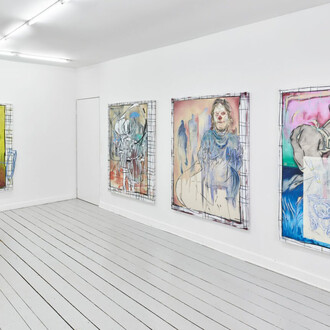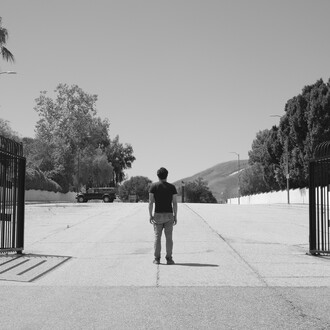Leon Kahane’s exhibition Dialog dialog dialog presents four works that explore how both art and politics engage with memory, responsibility and guilt. In each case, the reference to and interpretation of history serves as a framework of legitimacy for contemporary political and artistic forms of expression.
"To form an image... is what makes us human" is written at the entrance of a pavilion that opened in Auschwitz on February 9, 2024. On its facade, large rusted letters read: “Gerhard Richter Birkenau.” The original quote is from Gerhard Richter and first appeared in 1962: “To form an image, to have a vision, is what makes us human – art is the creation of meaning, the shaping of meaning, akin to the search for God and religion.” Inside the pavilion, visitors find the so-called photographic versions of Richter’s Birkenau series (2014). Unlike the original paintings, each of the four 260 x 200 cm works is composed of four individual panels. The series is based on the only four photographs taken by prisoners inside the camp. These photographs have been the subject of a controversial debate between Georges Didi-Huberman and Claude Lanzmann, one that also draws on ideas from Theodor W. Adorno and others.
Kahane’s work February 9, 2024 – Auschwitz places Richter’s quote at the center of a critical examination of the pavilion. The quote is shown in three languages – German, English and Polish – across four white sheets, mirroring the format and arrangement of Richter’s photographic Birkenau versions. In addition to the quote and the adapted print format, the exhibition includes a photograph of the original pavilion model and of the symbolic key used in the opening ceremony. The key, baked in the shape of a braided loaf of challah, represents the inauguration of the pavilion.
“Few religious principles have shaped Judaism as profoundly as the prohibition on images – both in aesthetic and ethical terms. The rejection of idolatry introduced by the Mosaic commandments also marked a turn toward abstraction, a ‘triumph of spirituality over sensuality’ (Freud), which downplayed the role of sensory experience in faith. To this day, it marks a central difference between Jewish and Christian theology and religious practice.”
This passage is excerpted from a concept paper written for an art competition organized by the Cologne Cathedral. The competition was initiated as an artistic response to the various antisemitic depictions found within the cathedral. The concept paper, Abstraction and figuration – The dialectic of the prohibition of images and antisemitic representation, was transferred onto a lithographic stone for the exhibition Dialog dialog dialog. Kahane’s draft, which also references Richter’s cathedral window, links back to Richter’s quote and expands the discussion of representability to a fundamental conflict between Christian and Jewish theology – a conflict that is especially pronounced in the contrast between abstraction and figuration.
The text continues: “Modern antisemitism, understood through thinkers such as Adorno as a pathological projection onto Jews, equates them with commerce and money – with abstraction itself. In a delusional response to processes of internal and external alienation, modern antisemitism primarily serves to relieve individual and collective conflicts and contradictions. The antisemitic imagery found on Cologne Cathedral can also be understood in this way – as an expression of the cathartic function of antisemitic resentment, in which ‘the Jews’ are blamed as the cause of all the world’s evils.”
The work September 1, 2024 – Zwickau consists of a series of portraits created by transferring analog photo contacts from a mobile phone screen to C-prints. The interaction between the screen’s light and the photo paper produces a color spectrum reminiscent of the German national flag. The portraits are cropped stills from a phone video showing a demonstration by the far-right party Der dritte weg (The third way) on September 1, 2024 – the day of state elections in Saxony and Thuringia – in Zwickau. The party advocates for a German socialism and openly wages a culture war in favor of “Germanic traditions.”
The political and cultural struggle of the New Right is also being waged through activist and political attacks on memorial sites. Particularly in the eastern federal states, the legitimation of far-right politics is increasingly achieved through the delegitimization of remembrance work. For the culture warriors, it is clear that political change cannot succeed without a radical break with the culture of remembrance.
The film March 24, 2022 – Birkenau addresses the challenges of memory politics and remembrance culture. Conservation efforts at the Auschwitz-Birkenau memorial site serve as an analogy for the dilemma of remembrance itself: on the one hand, the atrocities of the past must never be forgotten, as remembrance can inform a better present and future; on the other hand, the passing of the last eyewitnesses marks a turning point in collective memory and raises urgent questions about how the Holocaust’s history and its societal relevance can be conveyed to future generations.
Under the title Dialog dialog dialog, the four works come together to form a critical topography of remembrance and historical reckoning. Particular attention is given to the significance of memory in addressing foundational artistic questions, and to the shifting of political conflict into a culture war – a war in which interpretations of antisemitism and the Holocaust, eighty years after the liberation of Auschwitz, are once again moving to the center of a larger systemic debate.















